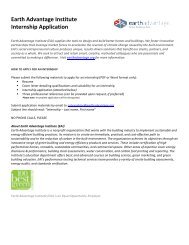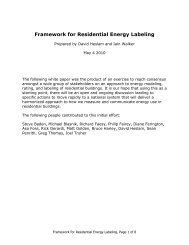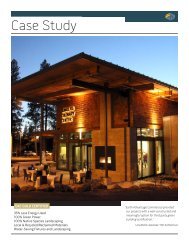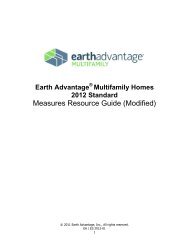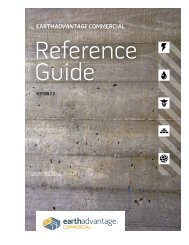EA New Homes Measures Guide - Earth Advantage
EA New Homes Measures Guide - Earth Advantage
EA New Homes Measures Guide - Earth Advantage
You also want an ePaper? Increase the reach of your titles
YUMPU automatically turns print PDFs into web optimized ePapers that Google loves.
2012 <strong>Earth</strong> <strong>Advantage</strong> Residential<br />
<strong>Measures</strong> Resource <strong>Guide</strong><br />
7.2.2<br />
No added Urea-Formaldehyde (25-50% / 51-75% / 76-100%)<br />
Accountability Form: General<br />
Energy<br />
Health<br />
Materials<br />
Water<br />
0 1/2/3 0 0 0<br />
Description: Use plywood, particle board and MDF that doesn't contain added urea-formaldehyde. Components that qualify are kitchen<br />
cabinets (50 percent), bathroom vanities (25 percent) and closet shelving (25 percent). Garage storage is not included.<br />
Land<br />
Benefit: The most common material for a cabinet carcass is interior grade particleboard, which contains a volatile urea-formaldehyde<br />
binder. Alternative binders, such as exterior grade phenol-formaldehyde, methyl-diisocyanate (MDI) and newer soy-based binders do not<br />
contain volatile formaldehyde. Cabinet makers who use one of these alternatives are improving the indoor air quality of the home, and<br />
reducing their own exposure. Breathing formaldehyde is unhealthy (see Glossary), so points are awarded for reducing the presence of<br />
materials containing it.<br />
Verification: Builder or responsible party must sign an Accountability Form attesting that the product is formaldehyde free. <strong>EA</strong> Verifier will<br />
determine the percentage of material based on a visual inspection.<br />
7.2.3<br />
Recycled Content Countertop: 25% Post-consumer content<br />
Accountability Form: General<br />
Energy<br />
Materials<br />
Water<br />
0 0 0 1 0<br />
Description: To gain points under this measure, countertop material must contain 25 percent post-consumer recycled content. Examples of<br />
products that meet this measure would be certain brands of porcelain tile, Richlite, Paperstone, glass, terrazzo, wood, bio-composites and<br />
concrete counters containing fly-ash.<br />
Health<br />
Land<br />
Benefit: Countertops are a very prominent feature in most homes. Typical plastic laminate materials are easily worn, stained and scarred,<br />
needing to be replaced frequently. Counter materials that contain recycled content reduce the amount of raw materials used and the<br />
amount of waste sent to landfills.<br />
Verification: <strong>EA</strong> Rater can visually identify known products. If the type of material is not known, the builder must provide product literature<br />
or an Accountability Form that specifies product name and the amount of recycled content.<br />
7.2.4<br />
Built-in Recycling Center: Minimum 2 major receptacles<br />
Energy<br />
Health<br />
Materials<br />
Water<br />
0 0 1 0 0<br />
Description: Install built-in storage bins located conveniently near where recyclable materials are generated, such as in the kitchen.<br />
Dedicated bins or receptacles should be present that are clearly distinct from household waste receptacles.<br />
Land<br />
Benefit: A designated recycling center avoids the messy clutter of loose cans and paper by providing a neat, orderly place for all<br />
recyclables. Placing it with easy access to the kitchen encourages everyone to use it.<br />
Verification: <strong>EA</strong> Rater will verify the presence of at least two bins or receptacles dedicated to recyclable materials.<br />
7.3 Millwork and Interior Trim<br />
Page 51 of 70



